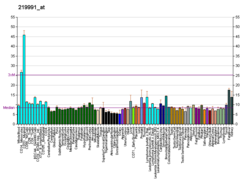
Summary
Solute carrier family 2, facilitated glucose transporter member 9 is a protein that in humans is encoded by the SLC2A9 gene.[5][6][7]
| SLC2A9 | |||||||||||||||||||||||||||||||||||||||||||||||||||
|---|---|---|---|---|---|---|---|---|---|---|---|---|---|---|---|---|---|---|---|---|---|---|---|---|---|---|---|---|---|---|---|---|---|---|---|---|---|---|---|---|---|---|---|---|---|---|---|---|---|---|---|
| Identifiers | |||||||||||||||||||||||||||||||||||||||||||||||||||
| Aliases | SLC2A9, solute carrier family 2 (facilitated glucose transporter), member 9, GLUT9, GLUTX, UAQTL2, URATv1, solute carrier family 2 member 9 | ||||||||||||||||||||||||||||||||||||||||||||||||||
| External IDs | OMIM: 606142 MGI: 2152844 HomoloGene: 69290 GeneCards: SLC2A9 | ||||||||||||||||||||||||||||||||||||||||||||||||||
| |||||||||||||||||||||||||||||||||||||||||||||||||||
| |||||||||||||||||||||||||||||||||||||||||||||||||||
| |||||||||||||||||||||||||||||||||||||||||||||||||||
| |||||||||||||||||||||||||||||||||||||||||||||||||||
| |||||||||||||||||||||||||||||||||||||||||||||||||||
| Wikidata | |||||||||||||||||||||||||||||||||||||||||||||||||||
| |||||||||||||||||||||||||||||||||||||||||||||||||||
This gene encodes a member of the SLC2A facilitative glucose transporter family. Members of this family play a significant role in maintaining glucose homeostasis. The encoded protein may play a role in the development and survival of chondrocytes in cartilage matrices. Two transcript variants encoding distinct isoforms have been identified for this gene.[7]
SLC2A9 has also recently been found to transport uric acid, and genetic variants of the transporter have been linked to increased risk of development of both hyperuricemia, gout and Alzheimer's disease.[8][9][10]
See also edit
References edit
- ^ a b c GRCh38: Ensembl release 89: ENSG00000109667 – Ensembl, May 2017
- ^ a b c GRCm38: Ensembl release 89: ENSMUSG00000005107 – Ensembl, May 2017
- ^ "Human PubMed Reference:". National Center for Biotechnology Information, U.S. National Library of Medicine.
- ^ "Mouse PubMed Reference:". National Center for Biotechnology Information, U.S. National Library of Medicine.
- ^ Phay JE, Hussain HB, Moley JF (Aug 2000). "Cloning and expression analysis of a novel member of the facilitative glucose transporter family, SLC2A9 (GLUT9)". Genomics. 66 (2): 217–20. doi:10.1006/geno.2000.6195. PMID 10860667.
- ^ Manolescu AR, Augustin R, Moley K, Cheeseman C (Aug 2007). "A highly conserved hydrophobic motif in the exofacial vestibule of fructose transporting SLC2A proteins acts as a critical determinant of their substrate selectivity". Mol Membr Biol. 24 (5–6): 455–63. doi:10.1080/09687680701298143. PMID 17710649. S2CID 35331716.
- ^ a b "SLC2A9 solute carrier family 2 member 9 [ Homo sapiens (human) ]".
- ^ Vitart V, Rudan I, Hayward C, et al. (2008). "SLC2A9 is a newly identified urate transporter influencing serum urate concentration, urate excretion and gout". Nature Genetics. 40 (4): 437–42. doi:10.1038/ng.106. PMID 18327257. S2CID 6720464.
- ^ Döring A, Gieger C, Mehta D, et al. (2008). "SLC2A9 influences uric acid concentrations with pronounced sex-specific effects". Nature Genetics. 40 (4): 430–6. doi:10.1038/ng.107. PMID 18327256. S2CID 29751482.
- ^ Hollingworth P, Sweet R, Sims R, et al. (2012). "Genome-wide association study of Alzheimer's disease with psychotic symptoms". Molecular Psychiatry. 17 (12): 1316–1327. doi:10.1038/mp.2011.125. PMC 3272435. PMID 22005930.
Further reading edit
- Doege H, Bocianski A, Joost HG, Schürmann A (2001). "Activity and genomic organization of human glucose transporter 9 (GLUT9), a novel member of the family of sugar-transport facilitators predominantly expressed in brain and leucocytes". Biochem. J. 350. Pt 3 (3): 771–6. doi:10.1042/0264-6021:3500771. PMC 1221309. PMID 10970791.
- Shikhman AR, Brinson DC, Valbracht J, Lotz MK (2001). "Cytokine regulation of facilitated glucose transport in human articular chondrocytes". J. Immunol. 167 (12): 7001–8. doi:10.4049/jimmunol.167.12.7001. PMID 11739520.
- Mobasheri A, Neama G, Bell S, et al. (2002). "Human articular chondrocytes express three facilitative glucose transporter isoforms: GLUT1, GLUT3 and GLUT9". Cell Biol. Int. 26 (3): 297–300. doi:10.1006/cbir.2001.0850. PMID 11991658. S2CID 34492031.
- Strausberg RL, Feingold EA, Grouse LH, et al. (2003). "Generation and initial analysis of more than 15,000 full-length human and mouse cDNA sequences". Proc. Natl. Acad. Sci. U.S.A. 99 (26): 16899–903. Bibcode:2002PNAS...9916899M. doi:10.1073/pnas.242603899. PMC 139241. PMID 12477932.
- Richardson S, Neama G, Phillips T, et al. (2003). "Molecular characterization and partial cDNA cloning of facilitative glucose transporters expressed in human articular chondrocytes; stimulation of 2-deoxyglucose uptake by IGF-I and elevated MMP-2 secretion by glucose deprivation". Osteoarthr. Cartil. 11 (2): 92–101. doi:10.1053/joca.2002.0858. PMID 12554125.
- Ota T, Suzuki Y, Nishikawa T, et al. (2004). "Complete sequencing and characterization of 21,243 full-length human cDNAs". Nat. Genet. 36 (1): 40–5. doi:10.1038/ng1285. PMID 14702039.
- Augustin R, Carayannopoulos MO, Dowd LO, et al. (2004). "Identification and characterization of human glucose transporter-like protein-9 (GLUT9): alternative splicing alters trafficking". J. Biol. Chem. 279 (16): 16229–36. doi:10.1074/jbc.M312226200. PMID 14739288.
- Gerhard DS, Wagner L, Feingold EA, et al. (2004). "The status, quality, and expansion of the NIH full-length cDNA project: the Mammalian Gene Collection (MGC)". Genome Res. 14 (10B): 2121–7. doi:10.1101/gr.2596504. PMC 528928. PMID 15489334.
This article incorporates text from the United States National Library of Medicine, which is in the public domain.







